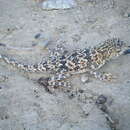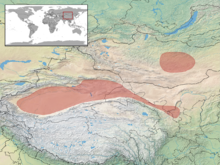en
names in breadcrumbs


Phrynocephalus versicolor, the Tuvan toad-headed agama, is a species of agamid lizard found in desert areas of China and Mongolia. It was first described by the Russian herpetologist Alexander Strauch, director of the Zoological Museum at the Imperial Academy of Sciences at St. Petersburg.[2]
Three subspecies, including the nominate one, are recognized:[3]
Phrynocephalus versicolor grows to a length of about 13 cm (5 in) including the tail, which is longer than the combined head and body. The head is large and rounded and the blunt snout has an oblique profile which makes the nostrils easily visible from above. There is no transverse fold of skin across the shoulders. There are large scales which are smooth and unribbed along the spine. Other dorsal scales are thickened with their rear margin slightly raised, which gives the lizard a rough appearance. Scales on the ventral surface are extended into short spines. The tail is long and tapering, flattened at the base and cylindrical further from the body. It is thickened at the base in the male. The colour is variable. The dorsal surface of the body is olive or leaden-grey with two to five transverse bars of brownish-black, the most intense colour being just behind the shoulders and there is often an orange patch in the armpit. The legs are also banded with darker colour and the underparts are white. The tail has up to nine dark bars, some of them extending to the underside, and the tip is black underneath.[4]
Phrynocephalus versicolor occurs in Mongolia and in the provinces of Xinjiang, Gansu, Ningxia, and Nei Mongol in China. It is found on stony plains and slopes, in canyons and on sand dunes with sagebrush and other sparse scrubby vegetation.[1] Much of its habitat is more than 3,200 m (10,500 ft) above sea level and the temperature can vary from −30 °C (−22 °F) in the winter to 40 °C (104 °F) in the summer. There is very little precipitation, and the small amount of rainfall is concentrated in mid-summer.[4]
Phrynocephalus versicolor hibernates during the winter and is active between March and the end of September. During summer it remains in its burrow during the cold nights and midday heat. The burrow is unbranched, has a single entrance and ends in a chamber some 10 to 13 cm (4 to 5 in) beneath the surface of the ground. This lizard feeds on small invertebrates such as ants, flies, grasshoppers and ground beetles. When rain falls, it stands with its hind legs straightened, its front legs bent and its head lowered, so that water landing on its back trickles towards its mouth.[4]
A female becomes sexually mature when about 9 cm (3.5 in) long. In the rainy season she digs a hole in damp ground some 5 cm (2 in) deep in which she lays a clutch of up to five white or pink-tinged eggs. Incubation takes about thirty days and the young are about 5 cm (2 in) long when they hatch. They exhibit great diversity in colour and adopt a stance similar to that of adults when rain is falling.[4]
Phrynocephalus versicolor has a wide range and is common in its arid habitats. The population is stable and no particular threats have been identified so the International Union for Conservation of Nature has assessed its status as being of "least concern".[1]
Phrynocephalus versicolor, the Tuvan toad-headed agama, is a species of agamid lizard found in desert areas of China and Mongolia. It was first described by the Russian herpetologist Alexander Strauch, director of the Zoological Museum at the Imperial Academy of Sciences at St. Petersburg.
La agama cabeza de sapo multicolor (Phrynocephalus versicolor) es una especie de lagartijas agamas encontradas en las áreas desérticas de China y Mongolia. Fue primeramente descrita por el herpetólogo ruso Alexander Strauch, director del Museo Zoológico en la Academia Imperial de Ciencias de San Petersburgo.[1]
Hay cuatro subespecies, incluyendo la aquí descrita, reconocida
La Phrynocephalus versicolor crece hasta una longitud de alrededor de 13 cm incluyendo su cola, la cual es mucho más larga que su cabeza y cuerpo combinado. Su cabeza es larga y redondeada y su hocico achatado tiene un perfil oblicuo lo que hace que sus fosas nasales sean visibles fácilmente desde arriba. No existe un pliegue transversal de piel a través de los hombros. Hay grandes escamas que son uniformes y sin surcos (ribetes) a través de la espina dorsal. Otras escamas dorsales son gruesas con su borde posterior ligeramente levantadas, lo que da a la lagartija una apariencia rugosa.[2]
Phrynocephalus versicolor se encuentra en Mongolia y en las provincias de Xinjiang, Gansu, Ningxia y Nei Mongol en China. Se encuentra en llanos y laderas pedregosas, en cañones y dunas con artemisas y otras clases vegetación árida escasa. Mucho de su hábitat está a más de 3200 metros (10500 pies) sobre el nivel del mar y la temperatura puede variar entre -30°C (-22 °F) y de noche 40°C (140°F) de día. Hay muy poca precipitación y la cantidad pequeña de lluvia se concentra a mitad del verano.
Phrynocephalus versicolor hiberna durante el invierno y están activas entre marzo y a finales de septiembre. Durante el verano se mantiene en su madriguera durante las noches frías y el mediodía caluroso. La madriguera no tiene ramificaciones, solo tiene una entrada y termina en una cavidad de alrededor de 10 a 13 cm (4 a 5 pulgadas) por debajo de la superficie de la tierra. La lagartija se alimenta de pequeños invertebrados tales como hormigas, moscas, saltamontes y escarabajos. Cuando la lluvia cae, se para con sus patas traseras extendidas, sus patas delanteras dobladas y su cabeza baja, para que de esa manera el agua que cae sobre su espalda gotee hacia su boca.
La hembra es sexualmente madura cuando alcanza los 9 cm (3.5 pulgadas) de longitud. En la época lluviosa cava un hoyo en la tierra húmeda de unos 5cm (2 pulgadas) de profundidad en donde ella pone una nidada de hasta cinco huevos blancos o rosados matizados. La incubación demora cerca de treinta días y la cría es de 5cm (2pulgadas) de largo cuando eclosionan. Ellos demuestran grande versatilidad en color y adoptan una postura similar a la de los adultos cuando la lluvia cae.
Phrynocephalus versicolor tiene una amplia variedad y es más común en su hábitat árido. La población es estable y ninguna amenaza en particular ha sido identificada, de esa manera la Unión Internacional para la conservación de la Naturaleza ha asignado su estado de “preocupación menor”.
La agama cabeza de sapo multicolor (Phrynocephalus versicolor) es una especie de lagartijas agamas encontradas en las áreas desérticas de China y Mongolia. Fue primeramente descrita por el herpetólogo ruso Alexander Strauch, director del Museo Zoológico en la Academia Imperial de Ciencias de San Petersburgo.
Phrynocephalus versicolor Phrynocephalus generoko animalia da. Narrastien barruko Agamidae familian sailkatuta dago.
Phrynocephalus versicolor Phrynocephalus generoko animalia da. Narrastien barruko Agamidae familian sailkatuta dago.
Phrynocephalus versicolor est une espèce de sauriens de la famille des Agamidae[1].
Cette espèce se rencontre[1] :
Selon Reptarium Reptile Database (9 mai 2012)[2] :
Phrynocephalus versicolor là một loài thằn lằn trong họ Agamidae. Loài này được Strauch mô tả khoa học đầu tiên năm 1876.[1]
Phrynocephalus versicolor là một loài thằn lằn trong họ Agamidae. Loài này được Strauch mô tả khoa học đầu tiên năm 1876.

变色沙蜥(学名:Phrynocephalus versicolor)为鬣蜥科沙蜥属的爬行动物。分布于哈萨克斯坦、吉尔吉斯斯坦、蒙古以及中国的新疆、宁夏、内蒙古等地,一般栖息于荒漠草原、干旱的荒漠、半荒漠及与干草原交界的边缘地区。该物种的模式产地在内蒙古阿拉善沙漠。[1]